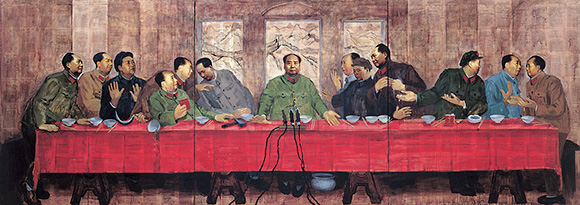Under the political clampdown after the Tiananmen Incident (1989), many avant-garde artists felt hampered to express their socially critical side. Painting with a cynical attitude, they recycled images from propaganda posters and from the Cultural Revolution in their works. Mao Zedong became a frequent and favored subject of what came to be named Political Pop, or Mao Pop. The phenomenon echoed the sudden enthusiasm for Mao relics and Cultural Revolution songs (set to a discobeat) in Chinese society.

Zhang Hongtu, The Last Banquet, 1989
The image above, The Last Banquet (laser prints, pages of the Red Book and acrylic on canvas, 1989), is one of the best examples of Mao Pop. It is not a poster, and it is not in the Landsberger/IISH collection. The artist, Zhang Hongtu, has graciously given permission to use it in these pages. Many more samples of Hongtu’s art (both Mao Pop, which includes the Mao Zedong acupuncture chart, and other works) can be found on his excellent webpage MoMao  .
.
Julia F. Andrews & Gao Minglu, "The avant-garde’s challenge to official art", in Deborah S. Davis, Richard Kraus, Barry Naughton, and Elisabeth J. Perry (eds), Urban Spaces in Contemporary China: The Potential for Autonomy and Community in Post-Mao China (Woodrow Wilson Center Press) (Cambridge, etc.: Cambridge University Press, 1995), pp. 221-278
Geremie Barmé, Shades of Mao: The Posthumous Cult of the Great Leader (Armonk, N.Y.: M.E. Sharpe 1996)
Francesca Dal Lago, "Personal Mao: Reshaping an Icon in Contemporary Chinese Art", Art Journal, Vol. 58, No. 2 (Summer, 1999), pp. 46-59. online at: http://www.jstor.org/stable/777948 
Alan Riding, "Chinese Artists Look Back", International Herald Tribune (28 September 1996)